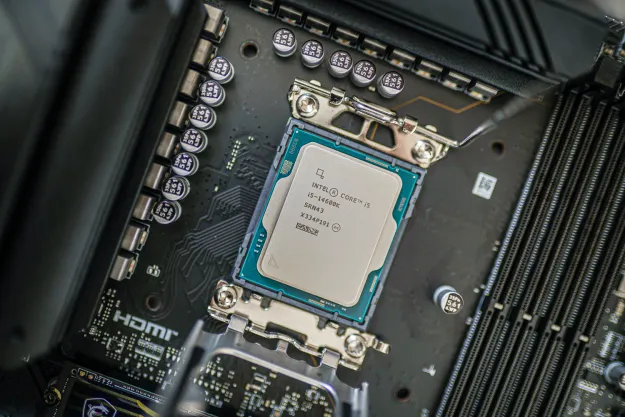Clay Bavor from Google’s virtual reality team revealed Daydream — a platform for Android that consists of high-quality smartphones, a headset, a controller, and Android apps built from the ground up for high-definition VR — on Wednesday during the Google I/O keynote. Daydream is the successor to the current Google Cardboard VR solution, which supports most Android and iOS phones, and consists of low-resolution VR apps and Google’s cheap cardboard headset.
According to Bavor, the new Daydream platform will make its debut this fall. The company has provided manufacturers with a specific list of specifications that will make their Android smartphones Daydream certified, although Bavor didn’t reveal that list during his presentation. Even so, Huawei officially announced support for Daydream, with compatible smartphones, tablets, and controllers arriving by the end of the year. Additionally, Bavor revealed a group of other handset makers that have already jumped on board, including HTC, ZTE, Samsung, LG, and more.
Daydream-compatible apps will soon be provided by the likes of Netflix, Hulu, IMAX, HBO NOW, CNN, and a few others.
To give you an idea of what a Daydream smartphone may require, the Huawei Nexus 6P is said to qualify for Google’s VR platform. This device sports a 5.7-inch AMOLED display with a 2,560 × 1,440 resolution, a 12.3MP camera on the back, an 8MP camera on the front, Qualcomm’s Snapdragon 810 processor clocked at 2GHz, 3GB of LPDDR4 memory, and storage ranging from 32GB to 128GB.
In addition, Android “N” will be optimized for virtual reality and feature a specific VR mode. Google has focused on performance and latency with the platform, shooting for a latency of under 20 milliseconds. The user interface has been optimized so that notifications come through properly when a user is in VR. All these features should be available when
For the second component of Daydream, the headset, Google has created a reference design that the company is sharing with partners now for a retail fall release. This won’t be a repeat of Cardboard, but an actual “hard” headset customers will purchase outright from third-party manufacturers. Bavor said that there are a number of elements that need to be “just right” when creating a headset including optics, materials, and the overall comfort.
You can do some pretty awesome things with the Daydream controller. #IO16https://t.co/GMKIrNbPYS
— Google (@google) May 18, 2016
However, this headset won’t compete with the HTC Vive or Oculus Rift. Instead, Google is seemingly going after Samsung’s Gear VR, as the Daydream-certified smartphone will provide the screen and processing meat. Like Gear VR, users will presumably slip the phone into the hinged device holder on the headset, strap it on, and load up their favorite VR app.
The third component, the controller, looks like a rounded Wii remote sporting a few buttons, a scrolling touchpad, and a motion sensor. Bavor said that this device is just as important as the phone and headset, and that the company wanted to create a peripheral that’s not only optimized for VR, but powerful and intuitive. This “super flexible” device, slated for this fall, will enable users to flip virtual pancakes, cast a fishing rod, and more in a virtual environment.
Finally, you can’t have all this hardware and nothing to actually experience. Software is the last ingredient added in the Daydream recipe, and Bavor said that Daydream users will be able to access Google Play from within the VR experience. This access will be made available through the Daydream Home environment, which will play host to installed VR apps and downloaded content.
According to Bavor, Daydream-compatible apps will soon be provided by the likes of Netflix, Hulu, IMAX, HBO NOW, CNN, and a few others. Even a number of game publishers are jumping on the Daydream VR bandwagon such as Electronic Arts, Ubisoft, MinorityVR, NetEase, and several others.
On the Google front, the company is retooling a number of its apps for Daydream such as Google Play Movies, Street View, and Google Photos. A version of YouTube will also be built from the ground up for VR and support voice search, playlists, spacial audio, and more. VR streaming will be improved, Bavor said, and in turn viewers will be able to experience events, concerts, and travel to places their wallets simply can’t afford.
In a separate announcement, NetEase revealed on Wednesday that it’s currently developing a game for Daydream called Twilight Pioneers. This will be one of the platform’s first gaming titles, an action RPG set in a fantasy world. What makes this announcement stand out is that the game will be a launch title, which the company says will happen in November 2016. That gives us a better target date than Google’s vague “fall” release window.
Unfortunately, that’s all we know about Google Daydream for now. Although the platform supposedly launches in November, developers can get started now with the latest developer preview of Android N. Additional information regarding Daydream is scheduled to be provided on Thursday, but for now we’re going to assume the Daydream headset itself will cost $100 if it’s anything like the Samsung Gear VR model.



